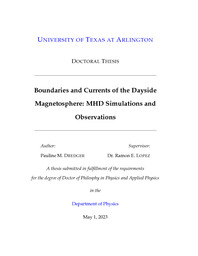
ATTENTION: The works hosted here are being migrated to a new repository that will consolidate resources, improve discoverability, and better show UTA's research impact on the global community. We will update authors as the migration progresses. Please see MavMatrix for more information.
Show simple item record
| dc.contributor.advisor | Lopez, Ramon E | |
| dc.creator | Dredger, Pauline Marie | |
| dc.date.accessioned | 2023-06-14T17:06:48Z | |
| dc.date.available | 2023-06-14T17:06:48Z | |
| dc.date.created | 2023-05 | |
| dc.date.issued | 2023-05-22 | |
| dc.date.submitted | May 2023 | |
| dc.identifier.uri | http://hdl.handle.net/10106/31258 | |
| dc.description.abstract | The solar wind streams through space at supersonic speeds, carrying plasma and the interplanetary magnetic field (IMF) from the sun. Earth’s magnetosphere presents a magnetosonic obstacle to the solar wind flow, which slows down suddenly, creating a bow shock. Between the bow shock and Earth’s magnetic field is the region of space called the magnetosheath, which contains the dense plasma and turbulent IMF of the shocked solar wind. The magnetopause is the boundary between the magnetosheath and the region of near-Earth space dominated by the terrestrial magnetic field; its location is determined by the competing pressures of the plasma in the magnetosheath and the magnetic pressure from inside the magnetosphere. Magnetopause position thus varies with the incoming solar wind conditions, which can affect the pressure from both regions. Because of the different magnetic field strengths and orientations on either side of both the bow shock and the magnetopause, the resulting magnetic shears give rise to currents on both boundaries, called the bow shock current and the magnetopause current.
The location of the magnetopause is important from a space weather perspective, since satellites can find themselves in either the magnetosphere or the magnetosheath as the magnetopause moves in response to the changing solar wind. To predict magnetopause motion, satellite operators often use one of several physics-based numerical models. We present our investigation of the abilities of four magnetohydrodynamic (MHD) models to accurately predict magnetopause location, comparing simulation results to spacecraft data. We find that two of the models tend to overpredict magnetopause motion, while the other two tend to underpredict, to a greater or lesser degree. We also find that, overall, the models do better when magnetopause motion is driven primarily by a plasma density increase in the magnetopause. Finally, we compare the performance of two of the models when coupled to an inner magnetosphere model, which includes the physics describing the toroidal current flowing around the earth called the ring current. The ring current, which is prominent during geomagnetic storms, affects the location of the magnetopause both directly, by an outward pressure, and indirectly, by its connection to currents flowing on magnetic field lines into the ionosphere.
Several currents in the magnetosphere close on the Chapman-Ferraro current, including the ionospheric field-aligned currents and the bow shock current. We present a case study investigating the relationship of these three current systems, using observations from both the magnetosphere and the ionosphere as well as an MHD simulation of the event. We find that, under certain solar wind conditions, a significant fraction of the bow shock current may close directly into the ionosphere on open field lines, bypassing the magnetopause current. | |
| dc.format.mimetype | application/pdf | |
| dc.language.iso | en_US | |
| dc.subject | Space physics | |
| dc.title | Boundaries and Currents of the Dayside Magnetosphere: MHD Simulations and Observations | |
| dc.type | Thesis | |
| dc.date.updated | 2023-06-14T17:06:48Z | |
| thesis.degree.department | Physics | |
| thesis.degree.grantor | The University of Texas at Arlington | |
| thesis.degree.level | Doctoral | |
| thesis.degree.name | Doctor of Philosophy in Physics and Applied Physics | |
| dc.type.material | text | |
| dc.creator.orcid | 0000-0003-1029-9168 | |
| local.embargo.terms | 2023-11-01 | |
| local.embargo.lift | 2023-11-01 | |
Files in this item
- Name:
- DREDGER-DISSERTATION-2023.pdf
- Size:
- 6.065Mb
- Format:
- PDF
This item appears in the following Collection(s)
Show simple item record


